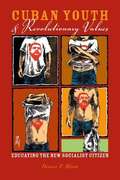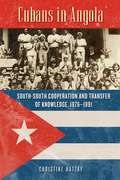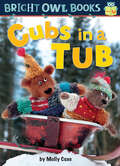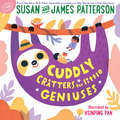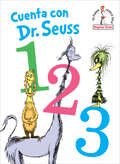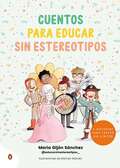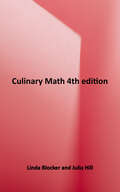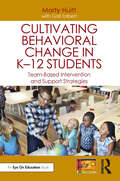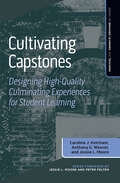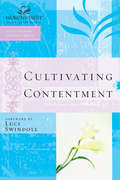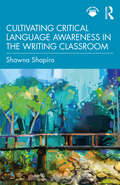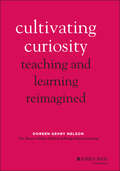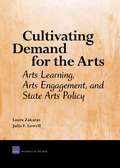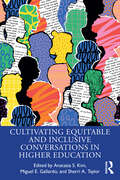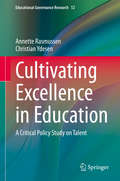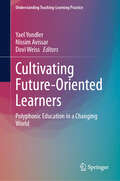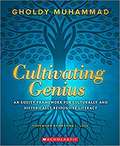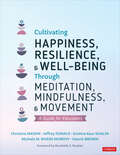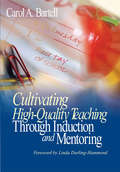- Table View
- List View
Cuban Youth and Revolutionary Values
by Denise F. BlumDrawing on extensive fieldwork in Havana's secondary schools, Cuban Youth and Revolutionary Values is a remarkable ethnography, charting the government's attempts to transform a future generation of citizens. While Cuba's high literacy rate is often lauded, the little-known dropout rates among teenagers receive less scrutiny. In vivid, succinct reporting, educational anthropologist Denise Blum now shares her findings regarding this overlooked aspect of the Castro legacy. Despite the fact that primary-school enrollment rates exceed those of the United States, the reverse is true for the crucial years between elementary school and college. After providing a history of Fidel Castro's educational revolution begun in 1953, Denise Blum delivers a close examination of the effects of the program, which was designed to produce a society motivated by benevolence rather than materialism. Exploring pioneering pedagogy, the notion of civic education, and the rural components of the program, Cuban Youth and Revolutionary Values brims with surprising findings about one of the most intriguing social experiments in recent history.
Cubans in Angola
by Christine HatzkyAngola, a former Portuguese colony in southern central Africa, gained independence in 1975 and almost immediately plunged into more than two decades of conflict and crisis. Fidel Castro sent Cuban military troops to Angola in support of the Movimento Popular de Libertação de Angola (MPLA), leading to its ascension to power despite facing threats both international and domestic. What is less known, and what Cubans in Angola brings to light, is the significant role Cubans played in the transformation of civil society in Angola during these years. Offering not just military support but also political, medical, administrative, and technical expertise as well as educational assistance, the Cuban presence in Angola is a unique example of transatlantic cooperation between two formerly colonized nations in the global South.
Cubs in a Tub (Bright Owl Books)
by Molly CoxeRuss and Gus are bored . . . until they take a tub for a ride. This fun photographic easy-to-read story features the short "u" vowel sound. Kane Press's new series of super simple easy-to-reads, Bright Owl Books, launches with Molly Coxe's five photographic stories, which feature the short vowel sounds and are each only around 100 words. These irresistibly silly stories help kids learn to read through repetition and by teaching the basic building blocks of reading—vowel sounds—giving kids the perfect start on educational success.
Cuddly Critters for Little Geniuses (Big Words for Little Geniuses #2)
by James Patterson Susan Patterson Hsinping PanAxolotes, chinchillas, and sugar gliders--oh my!In this charmingly illustrated follow-up to their first bestselling collaboration, Big Words for Little Geniuses, Susan and James Patterson create a collection of the world's oddest and cutest animals that only little geniuses would know!From sloths to spoonbills and panda ants to pangolins, little geniuses will love learning about all of the unusual, adorable animals that live on this planet. More than 50 little-known flyers, swimmers, and crawlers are included in this book, whimsically illustrated by artist Hsinping Pan. Cuddly Critters for Little Geniuses will remind you that nature contains many wonders--and these cute and curious creatures are no exception!
Cuenta con Dr. Seuss 1 2 3 (Beginner Books(R))
by Dr. Seuss¡Un libro para aprender a contar, en español y rimado, creado por Dr. Seuss e ilustrado con dibujos de sus libros! ¡Cuenta con Dr. Seuss y aprende los números mientras te diviertes! Este sencillo y rítmico riff acerca de contar está ilustrado con los dibujos de algunos de sus libros más queridos, entre otros: Un pez, dos peces, pez rojo, pez azul; El Gato Ensombrerado y ¡Yo puedo leer con los ojos cerrados! Pensado para los lectores principiantes, y para los que están aprendiendo a contar, ¡este libro es ideal para fomentar el amor por los números y por las historias de Dr. Seuss! Creada por Dr. Seuss, la colección de libros para primeros lectores (Beginner Books) anima a los niños a leer solos con palabras sencillas y divertidos dibujos que dan sentido a la lectura.Las ediciones rimadas en español de los clásicos de Dr. Seuss, publicadas por Random House, brindan la maravillosa oportunidad de disfrutar de sus historias a más de treinta y ocho millones de personas hispanohablantes en Estados Unidos. Los lectores podrán divertirse con las ediciones en español de The Cat in the Hat (El Gato Ensombrerado); Green Eggs and Ham (Huevos verdes con jamón); One Fish, Two Fish, Red Fish, Blue Fish (Un pez, dos peces, pez rojo, pez azul); The Lorax (El Lórax); Oh, the Places You'll Go! (¡Oh, cuán lejos llegarás!); How the Grinch Stole Christmas! (¡Cómo el Grinch robó la Navidad!); The Cat in the Hat Comes Back (El Gato Ensombrerado ha regresado); I Can Read with My Eyes Shut! (¡Yo puedo leer con los ojos cerrados!); Horton Hears a Who! (¡Horton escucha a Quién!); The 500 Hats of Bartholomew Cubbins (Los 500 sombreros de Bartolomé Cubbins); There's a Wocket in My Pocket! (¡Hay un Molillo en mi Bolsillo!); Mr. Brown Can Moo! Can You? (¡El Sr. Brown hace Muuu! ¿Podrías hacerlo tú?); Ten Apples Up on Top! (¡Diez manzanas en la cabeza!); What Pet Should I Get? (¿Cómo podré decidir qué mascota elegir?); Yertle the Turtle and Other Stories (Yoruga la Tortuga y otros cuentos); Oh, the Thinks You Can Think! (¡Oh, piensa en todo lo que puedes pensar!); The Foot Book! (¡Cuántos, cuántos pies!); Happy Birthday to You! (¡Feliz cumpleaños!); Come Over to My House (Ven a mi casa); Dr. Seuss's Sleep Book (¡Dormilones!); Would You Rather Be a Bullfrog? (¿Preferirías ser una rana?); Horton Hatches the Egg (Horton cuida un nido) y Dr. Seuss's 1 2 3 (Cuenta con Dr. Seuss 1 2 3). A rhymed Spanish concept book about counting, inspired by Dr. Seuss and illustrated with artwork from his books!Count on Dr. Seuss to make learning numbers fun! This simple, rhymed riff about counting is illustrated with art from some of his most beloved works, including One Fish, Two Fish, Red Fish, Blue Fish; The Cat in the Hat, and I Can Read with My Eyes Shut! Great for the earliest reader—and beginning counter—it's perfect for nurturing a love of numbers and of Dr. Seuss!
Cuentos para educar sin estereotipos
by Maria Oui OuiSeis cuentos para que los peques crezcan libres de estereotipos, ¡que nada les pare! ¿Cuántas veces has escuchado expresiones como «esto es de niños» o «esto es de niñas»? ¿Por qué Pepe no puede disfrazarse de María Antonieta? ¿Quién ha dicho que Daniela no puede ser la mejor pirata del mundo? ¿Por qué hay un pasillo de juguetes para niños y otro para niñas? ¡Atrévete a cambiar la respuesta a estas preguntas! Porque las niñas pueden ser piratas y los niños pueden ser princesas. Y porque el color rosa nos puede gustar a todos. A través de estas seis historias, tus peques aprenderán que pueden y deben ser libres a la hora de escoger juguetes, colores, prendas de ropa o cualquier otra cosa, y que eso no les hace ser más o menos niñas o niños. ¡Somos personas con gustos diferentes y en la diversidad está la riqueza! Crece sin límites con los cuentos para educar sin estereotipos.
Cuestión de educación: Un viaje por la enseñanza española
by Inés García-Albi¿Cómo es realmente la educación en España? ¿Cuáles son sus virtudes y cuáles sus defectos? Este libro es un esclarecedor recorrido por la educación española para aclarar el gran desconcierto y la confusión generalizada tras décadas de reformas contradictorias. La educación es un problema clave de España que nos afecta a todos: como alumnos, ex alumnos, padres o abuelos, profesores o simplemente como ciudadanos. Cuestión de educación es un diario de viaje, una road movie por el controvertido sistema educativo español. La periodista Inés García-Albi emprende un apasionante trabajo de campo por la enseñanza de este país para intentar descubrir qué es lo que ocurre con nuestro cuestionado sistema de educación. Inés vuelve a convertirse en alumna en colegios de todo tipo, interroga, indaga, busca respuestas a los principales temas que nos preocupan como padres y como ciudadanos. En Cuestión de educación se oye la voz de historiadores, políticos, inspectores, directores, profesores, madres, padres, alumnos, sindicalistas..., una respuesta coral que ofrece un panorama completo con sus luces y sombras, sus fracasos y logros (que también los hay) de la educación en este país.
Culinary Math 4th edition
by Julia Hill Linda BlockerWritten by two former instructors at The Culinary Institute of America, this revised and updated guide is an indispensable math resource for food service professionals everywhere. Covering topics such as calculating yield percent, determining portion costs, changing recipe yields, and converting between metric and U.S.
Culpados ou Inocentes
by G. G. Vega Nayra TavaresCulpados ou Inocentes é um livro onde examinamos os tipos de cidadãos que somos diante da lei, diante da justiça e diante de Deus. É um livro que te servirá para considerar o sentido e o valor das leis sociais, e nesse sentido te servirá como inspiração para futuras decisões de caráter importante e arriscado. Cada livro é como um pequeno mapa que te mostra silenciosamente os caminhos corretos para sua vida. Às vezes estes mapas chegam a tempo no momento certo e necessário, outras vezes nunca chegaram, não porque não existam, mas sim porque não lhe deram importância nos momentos em que se teve a oportunidade de acessá-los. Ler este breve livro não será uma perda de tempo para ninguém.
Cultivating Behavioral Change in K–12 Students: Team-Based Intervention and Support Strategies
by Marty Huitt Gail TolbertCultivating Behavioral Change in K-12 Students provides in-service educators with a long-term, team-based approach to enhancing their interventions and supports for struggling students. Given the clear visibility of trauma, crisis, and clinical challenges among children today, it is more important than ever that school professionals have the tools to create a more consistent culture of care at their schools. This book is driven by tried-and-true strategies refined across the three decades of implementation of the Behavior Intervention Support Team (BIST) Model. Comprehensive and compassionate, these evidence-based practices target the sustainable transformation of young learners’ behavior and help to shift the mindsets of the adults working with them. Principals, administrators, mental health practitioners, and teacher-leaders will be better prepared and motivated to collaborate toward student behavioral change, foster productive relationships with children and families, encourage learners to hone skills specific to behavior management, and more.
Cultivating Capstones: Designing High-Quality Culminating Experiences for Student Learning (Series on Engaged Learning and Teaching)
by Peter Felten Jessie L. Moore Caroline J. Ketcham Anthony G. WeaverCapstones have been a part of higher education curriculum for over two centuries, with the goal of integrating student learning to cap off their undergraduate experience. In practice, capstones are most often delivered as a course or include a significant project that addresses a problem or contributes new knowledge. This edited collection draws on multi-year, multi-institutional, and mixed-methods studies to inform the development of best practices for cultivating capstones at a variety of higher education institutions. The book is divided into three parts: Part One offers typographies of capstones, illustrating the diversity of experiences included in this high-impact practice while also identifying essential characteristics that contribute to high-quality culminating experiences for students. Part Two shares specific culminating experiences with examples from multiple institutions and strategies for adapting them for readers’ own campus contexts. Part Three offers research-informed strategies for professional development to support implementation of high-quality student learning experiences across a variety of campus contexts. Cultivating Capstones is an essential resource for faculty who teach or direct disciplinary or interdisciplinary capstone experiences, as well as for faculty developers and administrators seeking ways to offer high-quality, high-impact learning experiences for diverse student populations.Visit the Cultivating Capstones Companion Page, hosted by the Center for Engaged Learning.
Cultivating Coaching Mindsets: An Action Guide for Instructional Leaders
by Rita M. Bean Jacy IppolitoNow in a revised and updated second edition for today's changing K–12 landscape, this book gives instructional coaches an innovative framework for building strong relationships and enacting positive change in schools. Emphasizing a systems approach, Rita M. Bean and Jacy Ippolito explain the multiple roles of the coach as change agent, facilitator, designer, and advocate. Vivid examples show how effective coaches draw on these mindsets in working with individual teachers and groups and in developing, implementing, and sustaining schoolwide instructional programs. The book is rich with &“Voices from the Field&” vignettes; chapter-opening questions; and end-of-chapter discussion prompts, learning activities, and resources. Reproducible coaching tools can be copied from the book or downloaded from the companion website. New to This Edition *Broader scope--addresses coaching across all instructional areas, not just literacy. *Discussions of virtual instruction and coaching, the coach's role in supporting equity, and other timely topics. *Significantly revised case study chapter, with three new cases. *Incorporates current research, lessons learned in the field, and the ongoing development of the mindsets model.
Cultivating Communication in the Classroom: Future-Ready Skills for Secondary Students (Corwin Teaching Essentials)
by Lisa Ann JohnsonBuilding 21st Century communication skills Students are expected to be innovators, creative thinkers, and problem solvers. But what if they can't communicate their ideas persuasively? Knowing how to share ideas is as crucial as the ideas themselves. Unfortunately, many students don’t get explicit opportunities to hone this skill. Cultivating Communication in the Classroom will help educators design authentic learning experiences that allow students to practice their skills. Readers will find: Real world insights into how students will be expected to communicate in their future careers and education Strategies for teaching communication skills throughout the curriculum Communication Catchers for igniting ideas
Cultivating Communication in the Classroom: Future-Ready Skills for Secondary Students (Corwin Teaching Essentials)
by Lisa Ann JohnsonBuilding 21st Century communication skills Students are expected to be innovators, creative thinkers, and problem solvers. But what if they can't communicate their ideas persuasively? Knowing how to share ideas is as crucial as the ideas themselves. Unfortunately, many students don’t get explicit opportunities to hone this skill. Cultivating Communication in the Classroom will help educators design authentic learning experiences that allow students to practice their skills. Readers will find: Real world insights into how students will be expected to communicate in their future careers and education Strategies for teaching communication skills throughout the curriculum Communication Catchers for igniting ideas
Cultivating Contentment (Women of Faith Study Guide Series)
by Thomas NelsonFilling the needs of today's women, we offer the next 4 titles in the best-selling Women of Faith series.These topical guides deal with issues that women wrestle with today, such as friendship, encouragement, managing moods, finding contentment, and how to live out your faith. Reaching an audience across racial, socio-economic, denominational, and age boundaries, these guides will enhance the lives of women as they empower them in their weekly devotions. The study guides can be used for both individual and group settings. Women are asking good questions about their faith. With our study guides, we want to join them in their quest for knowledge and lead them in finding the answers they are seeking. The Study Guide Series will include the following:#5 Managing Your Moods - Foreword by Marilyn Meberg ISBN: 0-7852-5151-0#6 Cultivating Contentment - Foreword by Luci Swindoll ISBN: 0-7852-5152-9#7 Encouraging One Another - Foreword by Nicole Johnson ISBN: 0-7852-5153-7#8 A Life of Worship - Foreword by Sheila Walsh ISBN: 0-7852-5154-5
Cultivating Critical Language Awareness in the Writing Classroom
by Shawna ShapiroThis book introduces Critical Language Awareness (CLA) Pedagogy as a robust and research-grounded framework to engage and support students in critical examinations of language, identity, privilege and power.Starting with an accessible introduction to CLA, chapters cover key topics—including World Englishes, linguistic prejudice, news media literacy, inclusive language practices, and more—in an inviting and thought-provoking way to promote reflection and analysis. Part I provides an overview of the foundations of CLA pedagogy, while Part II highlights four instructional pathways for CLA pedagogy: Sociolinguistics, Critical Academic Literacies, Media/Discourse Analysis, and Communicating Across Difference. Each pathways chapter is structured around Essential Questions and Transferrable Skills, and includes three thematic learning sequences. Part III offers tools and guidance for tailoring CLA pedagogy to the reader’s own teaching context and to students’ individual needs. The volume’s wealth of resources and activities are a pedagogical toolkit for supporting and embracing linguistic diversity in the classroom. The cohesive framework, concrete strategies, engaging activities, and guiding questions in this volume allow readers to come away with not only a deeper understanding of CLA, but also a clear roadmap for implementing CLA pedagogy in the classroom. Synthesizing relevant research from educational linguistics and writing studies, this book is ideal for courses in English/literacy education, college composition, L2 writing instruction, and educational linguistics.
Cultivating Curiosity: Teaching and Learning Reimagined
by Doreen Gehry NelsonGive your students a leg up and improve learning outcomes with this revolutionary, hands-on approach to teaching In Cultivating Curiosity: Teaching and Learning Reimagined, distinguished educator and author Doreen Gehry Nelson inspires anyone yearning to break away from formulaic teaching. Told from dozens of powerful and personal perspectives, the effectiveness and versatility of the Doreen Nelson Method of Design-Based Learning described in the book is backed by years of quantitative and qualitative data. You’ll learn how applying this cross-curricular methodology can transform your K-12 teaching practice, regardless of changes in content standards. The book includes: Discussions about how to launch creative and critical thinking in your students Explanations of the methodology’s 6 ½ Steps of Backward Thinking™ that invigorate the teaching experience and dramatically improve learning The inception of the methodology and the experiences of K-12 teachers who practice it in their classrooms. Perfect for K-12 educators seeking a methodology that consistently engages students in applying what they learn, Cultivating Curiosity is also an ideal resource for teachers-in-training, administrators, and post-secondary educators.
Cultivating Demand for the Arts
by Laura Zakaras Julia F. LowellWhat does it mean to cultivate demand for the arts? Why is it important and necessary to do so? What can state arts agencies and other arts and education policymakers do to make it happen? The authors set out a framework for thinking about supply and demand in the arts and identify the roles that different factors, particularly arts learning, play in increasing demand for the arts.
Cultivating Equitable and Inclusive Conversations in Higher Education
by Sherri A. Taylor Miguel E. Gallardo Anatasia S. KimThis book is a practical guide for educators seeking to facilitate diversity, equity, and inclusion (DEI) conversations in higher education. More than ever, students expect their learning to address the pressing challenges in our world today. Against the backdrop of growing social justice movements, cancel culture, and deepening polarization, faculty and administrators require effective skills to navigate the strong opinions and emotions that arise when addressing social issues in the classroom and on campus. Authors in this timely volume unpack why DEI conversations are difficult, highlight common missteps when facilitating such conversations, and offer readers practical skills that support robust, inclusive, and meaningful discussions. Featuring real-world examples from educators on the front lines, this book provides actionable tools and practices to cultivate learning environments that foster student engagement, deep learning, inclusion, and a sense of belonging.
Cultivating Excellence in Education: A Critical Policy Study on Talent (Educational Governance Research #12)
by Christian Ydesen Annette RasmussenThis book critically analyses the current education political strategy of cultivating excellence in education. It shows how the new policy for selecting talented students in Denmark deconstructs the compromise from which the comprehensive school was built and reduces equal opportunities. It discusses how the current practice of measurement, selection and guidance of talented students brings about significant changes in education policies, in pedagogic practices, a restructuring of school organisations, and changed requirements of teachers. It explains how the internal differentiation of education systems based on self-selection and free choice, but also on new assessment techniques, tends to widen the inequality gap between students. The analysis clearly shows the relationship between the circulation of new ideas and normative frameworks at international level, and their transfer into national policies, while situating these developments in a socio-historical perspective. The book illustrates by means of a concrete case study with important empirical data that demonstrate the reality and influence of this new policy on the day-to-day work of teachers.
Cultivating Future-Oriented Learners: Polyphonic Education in a Changing World (Understanding Teaching-Learning Practice)
by Nissim Avissar Yael Yondler Dovi WeissThe book Cultivating Future-Oriented Learners: Polyphonic Education in a Changing World offers a new theoretical and practical educational approach, responding to our era's challenges. The polyphonic paradigm it proposes uses current educational elements to produce "a new whole" connecting technology, varied learning spaces, humanizing pedagogy, and global values of personal, social, and environmental responsibility. Combining all these elements, the presented polyphonic wisdom model enables teachers to design a technology-enhanced, pluralistic, and dynamic learning environment where individual voices are heard while all the voices harmonize. Centered around human dignity and affinity between the personal and collective good, it aspires to assist educators in cultivating productive and value-based future citizens and teachers within a democratic society. The book introduces thirteen unique teaching models to foster humanizing global values: diversity and inclusion, ecohumanistic responsibility, and a dialogue between diverse stands and perspectives. It guides learners toward attaining their objectives by acquiring independent learning skills. Together, these teaching models are a catalogue of practical implementation choices of the polyphonic wisdom model in various educational frameworks. The envisaged readership encompasses educators and related professionals, but no less so anyone concerned about the current educational crisis who wishes to rethink education, technology, and values such as present and future personal, social, and environmental responsibility.
Cultivating Genius: An Equity Framework for Culturally and Historically Responsive Literacy
by Gholdy MuhammadIn Cultivating Genius, Dr. Gholdy E. Muhammad presents a four-layered equity framework—one that is grounded in history and restores excellence in literacy education. This framework, which she names, Historically Responsive Literacy, was derived from the study of literacy development within 19th-century Black literacy societies. The framework is essential and universal for all students, especially youth of color, who traditionally have been marginalized in learning standards, school policies, and classroom practices. The equity framework will help educators teach and lead toward the following learning goals or pursuits: <P><P> Identity Development—Helping youth to make sense of themselves and others Skill Development— Developing proficiencies across the academic disciplines Intellectual Development—Gaining knowledge and becoming smarter Criticality—Learning and developing the ability to read texts (including print and social contexts) to understand power, equity, and anti-oppression <P><P> When these four learning pursuits are taught together—through the Historically Responsive Literacy Framework, all students receive profound opportunities for personal, intellectual, and academic success. Muhammad provides probing, self-reflective questions for teachers, leaders, and teacher educators as well as sample culturally and historically responsive sample plans and text sets across grades and content areas. In this book, Muhammad presents practical approaches to cultivate the genius in students and within teachers.
Cultivating Happiness, Resilience, and Well-Being Through Meditation, Mindfulness, and Movement: A Guide for Educators
by Christine Y. Mason Jeffrey Donald Krishna Kaur Khalsa Michele M. Murphy Valerie L. BrownIn chaotic times, a deep breath can bring calm to your classroom. As the pandemic recedes and the world gradually returns to “normal,” it’s more important than ever to make your classroom a place that supports mental health and improves overall wellness. In this book, you’ll discover the why and the how of using techniques to reduce stress, improve executive function, and set the stage for increased memory and attention, better self-regulation, and improved cognition and academic learning. With this practical, research-based guide, you’ll incorporate age- and grade-appropriate meditation, breathing, mindfulness, and secular yoga activities into your teaching, in ways that work for in-person as well as virtual and hybrid settings. Features include Adaptations for special populations, including those who have experienced trauma Recommendations for family involvement in social emotional learning Guidance on self-care for teachers and school staff Data from successfully implemented programs Dozens of illustrations, QR codes, and reflective questions Mindfulness isn’t just a buzzword-it’s a time-tested, teacher-tested technique for reducing anxiety and improving you students’ outcomes. Incorporate it into your classroom and see for yourself how much good a deep breath can do.
Cultivating Happiness, Resilience, and Well-Being Through Meditation, Mindfulness, and Movement: A Guide for Educators
by Christine Y. Mason Jeffrey Donald Krishna Kaur Khalsa Michele M. Murphy Valerie L. BrownIn chaotic times, a deep breath can bring calm to your classroom. As the pandemic recedes and the world gradually returns to “normal,” it’s more important than ever to make your classroom a place that supports mental health and improves overall wellness. In this book, you’ll discover the why and the how of using techniques to reduce stress, improve executive function, and set the stage for increased memory and attention, better self-regulation, and improved cognition and academic learning. With this practical, research-based guide, you’ll incorporate age- and grade-appropriate meditation, breathing, mindfulness, and secular yoga activities into your teaching, in ways that work for in-person as well as virtual and hybrid settings. Features include Adaptations for special populations, including those who have experienced trauma Recommendations for family involvement in social emotional learning Guidance on self-care for teachers and school staff Data from successfully implemented programs Dozens of illustrations, QR codes, and reflective questions Mindfulness isn’t just a buzzword-it’s a time-tested, teacher-tested technique for reducing anxiety and improving you students’ outcomes. Incorporate it into your classroom and see for yourself how much good a deep breath can do.
Cultivating High-Quality Teaching Through Induction and Mentoring
by Carol A. BartellThis indispensable handbook focuses on new teachers' needs while emphasizing high-quality teaching through the use of standards-based teaching, teacher assessments, and reflective practice.
